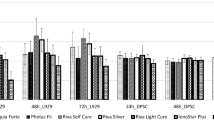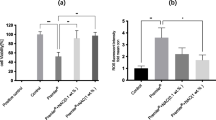Abstract
Unpolymerized resin (co)monomers or mercury (Hg) can be released from restorative dental materials (e.g. composites and amalgam). They can diffuse into the tooth pulp or the gingiva. They can also reach the gingiva and organs by the circulating blood after the uptake from swallowed saliva. The cytotoxicity of dental composite components hydroxyethylmethacrylate (HEMA), triethyleneglycoldimethacrylate (TEGDMA), urethanedimethacrylate (UDMA), and bisglycidylmethacrylate (Bis-GMA) as well as the amalgam component Hg2+ (as HgCl2) and methyl mercury chloride (MeHgCl) was investigated on human gingival fibroblasts (HGFs) at two time intervals. To test the cytotoxicity of substances, the bromodeoxyuridine (BrdU) assay and the lactate dehydrogenase (LDH) assay were used. The test substances were added in various concentrations and cells were incubated for 24 or 48 h. The EC50 values were obtained as half-maximum-effect concentrations from fitted curves. Following EC50 values were found [BrdU: mean (mmol/l); SEM in parentheses; n=12]: (24 h/48 h) HEMA 8.860 (0.440)/6.600(0.630), TEGDMA 1.810(0.130)/1.220(0.130), UDMA 0.120(0.010)/0.140(0.010), BisGMA 0.060(0.004)/0.040(0.002), HgCl2 0.015(0.001)/0.050(0.006), and MeHgCl 0.004(0.001)/0.005(0.001). Following EC50 values were found [LDH: mean (mmol/l); SEM in parentheses; n=12]: (24 h/48 h) HEMA 9.490(0.300)/7.890(1.230), TEGDMA 2.300(0.470)/1.950(0.310), UDMA 0.200(0.007)/0.100(0.007), BisGMA 0.070(0.005)/0.100(0.002), and MeHgCl 0.014(0.006)/0.010(0.003). In both assays, the following range of increased toxicity was found for composite components (24 and 48 h): HEMA < TEGDMA < UDMA < BisGMA. In both assays, MeHgCl was the most toxic substance. In the BrdU assay, Hg2+ was about fourfold less toxic than MeHgCl but Hg2+ was about fourfold more toxic than BisGMA. In the BrdU test, a significantly (P<0.05) decreased toxicity was observed for Hg2+ at 48 h, compared to the 24 h Hg2+-exposure. A time depending decreased toxicity was observed only for Hg2+ which can then reach the toxic level of BisGMA.



Similar content being viewed by others
References
Arechabala B, Coiffard C, Rivalland P, Coiffard LJM, de Roeck-Holtzhauer Y (1999) Comparison of cytotoxicity of various surfactants tested on normal human fibroblast cultures using the neutral red test, MTT assay and LDH release. J Appl Toxicol 3:163–165
Aschner M, Conklin DR, Yao CP, Allen JW, Tan KH (1998) Induction of astrocyte metallothioneins (MTs) by zinc confers resistance against the acute cytotoxic effects of methylmercury on cell swelling, Na+ uptake, and K+ release. Brain Res 2:254–261
Belletti S, Orlandini G, Vettori MV, Mutti A, Uggeri J, Scandroglio R, Alinovi R, Gatti R (2002) Time course assessment of methylmercury effects on C6 glioma cells: Submicromolar concentrations induce oxidative DNA damage and apoptosis. J Neurosci Res 5:703–711
Burtscher P (1993) Stability of radicals in cured composite-materials. Dent Mater 4:218–221
Camps J, Dejou J, Remusat M, About I (2000) Factors influencing pulpal response to cavity restorations. Dent Mater 6:432–440
Dillingham EO, Lawrence WH, Autian J, Schmalz G (1983) Acrylate and methacrylate esters—relationship of hemolytic-activity and in vivo toxicity. J Biomed Mater Res 6:945–957
Engelmann BE, Bindslev N, Poulsen SS, Hansen MB (2002) Effects of cyclooxygenase and lipoxygenase inhibition on basal- and serotonin-induced ion transport in rat colon. Compend Biochem Physiol 1:37–52
Engelmann J, Janke V, Volk J, Leyhausen G, Von Neuhoff N, Schlegelberger B, Geurtsen W (2004) Effects of BisGMA on glutathione metabolism and apoptosis in human gingival fibroblasts in vitro. Biomaterials 19:4573–4580
Ferracane JL (1994) Elution of leachable components from composites. J Oral Rehabil 4:441–452
Forst HAT (1985) Probleme des multiplen Testens und Schätzens in der Arzneimittelforschung. Arzneimittel Forschung/Drug Res 3:7–10
Gerzina TM, Hume WR (1994) Effect of dentin on release of tegdma from resin composite in-vitro. J Oral Rehabil 4:463–468
Gerzina TM, Hume WR (1996) Diffusion of monomers from bonding resin resin composite combinations through dentine in vitro. J Dent 1:125–128
Geurtsen W, Schoeler U (1997) A 4-year retrospective clinical study of class I and class II composite restorations. J Dent 3:229–232
Geurtsen W, Lehmann F, Spahl W, Leyhausen G (1998) Cytotoxicity of 35 dental resin composite monomers/additives in permanent 3T3 and three human primary fibroblast cultures. J Biomed Mater Res 3:474–480
Halbach S (1994) Amalgamfüllungen: Belastung oder Vergiftung mit Quecksilber? Deutsches Ärzteblatt 502–506
Halbach S, Reichl FX, Schiele R (1999) Stellungnahme zum Kieler Amalgam-Gutachten aus toxikologischer, arbeits- und umweltmedizinischer Sicht, in Amalgam im Spiegel kritischer Auseinandersetzung. Interdisziplinäre Stellungnahmen zum “Kieler Amalgam-Gutachten”, In: Halbach S (ed) Deutscher Ärzte-Verlag, Köln, pp 17–42
Hamid A, Okamoto A, Iwaku M, Hume WR (1998) Component release from light-activated glass ionomer and compomer cements. J Oral Rehabil 2:94–99
Horstedt-Bindslev P, (2004) Amalgam toxicity—environmental and occupational hazards. J Dent 32:359–365
Issa Y, Watts DC, Brunton PA, Waters CM, Duxbury AJ (2004) Resin composite monomers alter MTT and LDH activity of human gingival fibroblasts in vitro. Dent Mater 1:12–20
Kaga M, Noda M, Ferracane JL, Nakamura W, Oguchi H, Sano H (2001) The in vitro cytotoxicity of eluates from dentin bonding resins and their effect on tyrosine phosphorylation of L929 cells. Dent Mater 4:333–439
Kehe K, Reichl FX, Durner J, Walther U, Hickel R, Forth W (2001) Cytotoxicity of dental composite components and mercury compounds in pulmonary cells. Biomaterials 4:317–322
Kim SH, Sharma RP (2003) Cytotoxicity of inorganic mercury in murine T and B lymphoma cell lines: involvement of reactive oxygen species, Ca2+ homeostasis, and cytokine gene expression. Toxicol Vitro 4:385–395
Kleinsasser NH, Wallner BC, Harreus UA, Kleinjung T, Folwaczny M, Hickel R, Kehe K, Reichl FX (2004) Genotoxicity and cytotoxicity of dental materials in human lymphocytes as assessed by the single cell microgel electrophoresis (comet) assay. J Dent 3:229–234
Mahaffey KR, Clickner RP, Bodurow CC (2004) Blood organic mercury and dietary mercury intake: National Health and Nutrition Examination Survey, 1999 and 2000. Environ Health Perspect 5:562–570
Nakabayashi N, Takarada K (1992) Effect of HEMA on bonding to dentin. Dent Mater 2:125–130
Noda M, Wataha JC, Lockwood PE, Volkmann KR, Kaga M, Sano H (2003) Sublethal, 2-week exposures of dental material components alter TNF-alpha secretion of THP-1 monocytes. Dent Mater 19:101–105
Ott KHR, Loh F, Kröncke A, Schaller KH, Valentin H, Weltle D (1984) Zur Quecksilberbelastung durch Amalgamfüllungen. Deutsche Zahnärztliche Zeitschrift 199–205
Paranjpe A, Bordador LC, Wang MY, Hume WR, Jewett A (2005) Resin monomer 2-hydroxyethyl methacrylate (HEMA) is a potent inducer of apoptotic cell death in human and mouse cells. J Dent Res 84:172–177
Pastore A, Federici G, Bertini E, Piemonte F (2003) Analysis of glutathione: implication in redox and detoxification. Clin Chim Acta 1:19–39
Ratanasathien S, Wataha JC, Hanks CT, Dennison JB (1995) Cytotoxic interactive effects of dentin bonding components on mouse fibroblasts. J Dent Res 74:1602–1606
Reichl FX (2002a) Zahnfüllungsmaterialien, in Taschenatlas der Toxikologie, In: Reichl FX (ed) Thieme Verlag, Stuttgart, pp 243–245
Reichl FX, Durner J, Manhart J, Spahl W, Gempel K, Kehe K, Liebl B, Walther UI, Hume WR, Hickel R (2002b) Biological clearance of HEMA in guinea pigs. Biomaterials 10:2135–2141
Reichl FX, Walther UI, Durner J, Kehe K, Hickel R, Kunzelmann KH, Spahl W, Hume WR, Benschop H, Forth W (2001) Cytotoxicity of dental composite components and mercury compounds in lung cells. Dent Mater 2:95–101
Reichl FX, Esters M, Simon S, Seiss M, Kehe K, Kleinsasser N, Folwaczny M, Glas J, Hickel R (2005) Cell death effects of resin-based dental material compounds and mercurials in human gingival fibroblasts. Arch Toxicol (in press)
Repetto G, Sanz P, Repetto M (1993) In-vitro effects of mercuric-chloride and methylmercury chloride on neuroblastoma-cells. Toxicol Vitro 4:353–357
Schmalz G, Garhammer P (2002) Biological interactions of dental cast alloys with oral tissues. Dent Mater 18:396–406
Seiss M, Kehe K, Haffner C, El-Mahdy K, Hickel R, Nitz S, Walther UI, Mahnart J, Reichl FX (2004) Analytic of (toxic) intermediates from metabolized dental restorative materials. Naunyn-Schmiedeberg’s Arch Pharmacol R107
Spahl W, Budzikiewicz H, Geurtsen W (1998) Determination of leachable components from four commercial dental composites by gas and liquid chromatography mass spectrometry. J Dent 2:137–145
Stähle HJ (1997) Füllung und Versiegelung—Eine Risikoabschätzung bei Kunststoff-Materialien. Zahnärztl Mitt 4:364–374
Stanislawski L, Lefeuvre M, Bourd K, Soheili-Majd E, Goldberg M, Perianin A (2003) TEGDMA-induced toxicity in human fibroblasts is associated with early and drastic glutathione depletion with subsequent production of oxygen reactive species. J Biomed Mater Res 3:476–482
Szep S, Kunkel A, Ronge K, Heidemann D (2002) Cytotoxicity of modern dentin adhesives - In vitro testing on gingival fibroblasts. J Biomed Mater Res 1:53–60
Tanaka-Kagawa T, Suzuki M, Naganuma A, Yamanaka N, Imura N (1998) Strain difference in sensitivity of mice to renal toxicity of inorganic mercury. J Pharmacol Exp Ther 1:335–341
Toimela TA, Tahti H (1995) Effects of mercury, methylmercury and aluminum on glial fibrillary acidic protein expression in rat cerebellar astrocyte cultures. Toxicol Vitro 3:317–322
Walther UI, Walther SC, Liebl B, Reichl FX, Kehe K, Nilius M, Hickel R (2002) Cytotoxicity of ingredients of various dental materials and related compounds in L2- and A549 cells. J Biomed Mater Res 63:643–649
Wan QC, Rumpf D, Schricker SR, Mariotti, Culbertson BM (2001) Influence of hyperbranched multi-methacrylates for dental neat resins on proliferation of human gingival fibroblasts. Biomacromolecules 1:217–222
Wang XQ, Gao XX (1997) Voltammetric behavior studies on the interaction between lanthanide ions and NAD(+), NAD–LDH complex. Cheml J Chin Univ-Chin 7:1027–1030
Wataha JC, Lockwood PE, Bouillaguet S, Noda M (2003) In vitro biological response to core and flowable dental restorative materials. Dent Mater 19:25–31
Wirth M, Fuchs A, Wolf M, Ertl B, Gabor F (1998) Lectin-mediated drug targeting: preparation, binding characteristics, and antiproliferative activity of wheat germ agglutinin conjugated doxorubicin on Caco-2 cells. Pharmacol Res 7:1031–1037
Yoshii E (1997) Cytotoxic effects of acrylates and methacrylates: relationships of monomer structures and cytotoxicity. J Biomed Mater Res 4:517–524
Zalups RK, Aslamkhan AG, Ahmad S (2004) Human organic anion transporter 1 mediates cellular uptake of cysteine-S conjugates of inorganic mercury. Kidney Int 1:251–261
Acknowledgements
The authors would like to acknowledge the technical assistance of Sabine Domes and Stefan Schulz.
Author information
Authors and Affiliations
Corresponding author
Rights and permissions
About this article
Cite this article
Reichl, FX., Simon, S., Esters, M. et al. Cytotoxicity of dental composite (co)monomers and the amalgam component Hg2+ in human gingival fibroblasts. Arch Toxicol 80, 465–472 (2006). https://doi.org/10.1007/s00204-006-0073-5
Received:
Accepted:
Published:
Issue Date:
DOI: https://doi.org/10.1007/s00204-006-0073-5




